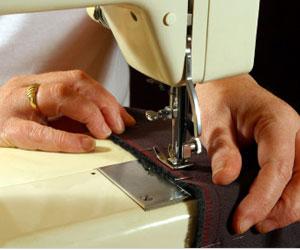- 5 Kids' Sewing Machines Perfect for Beginners
- Waistband Alteration Instructions
- How to Make Kids' Clothes: Clever DIY Tips
- How to Sew on Boy Scout Patches
- How to Make Personalized Sewing Labels
- How to Hem Jeans Without a Sewing Machine
- Best Sewing Machines for Jeans
- How to Sew a Minky Baby Blanket
- Sewing Machines for Beginners
- Free Sewing Machine Cover Pattern
- How to Make Reusable Lunch Bags
- How to Make a Shirt Quilt
Sewing Categories

Sewing has been around for as long as people have been able to use natural materials to hold together animal skins. The first evidence of sewing dates back about 20,000 years, and archaeologists have found bone needles that would have been used to sew animal skins together to make the first clothing.
"Modern" Sewing
Sewing as we know it began to emerge when cotton, wool and other fibers began to be spun into thread and cloth. Young girls were taught to sew beautiful and well-made objects that illustrated their worth as wives and mothers.
It is interesting, then, that all of the early contributors to the development of the sewing machine were men. The first sewing machine needle was developed in 1755 by Karl Weisenthal, but it wasn't until 1790 that Englishman Thomas Saint patented the first sewing machine, which was designed to sew boots and used an awl instead of a needle.
Saint's machine never took off. It was 1830 before Barthelemy Thimonnier, a French tailor, patented the first really practical sewing machine. Eight of these machines were put into use by the French army, but the factory was destroyed by a mob of angry tailors before the machines could gain widespread popularity.
American Sewing Machines
Call it Yankee ingenuity if you want, but it's true that the innovations that brought sewing machines into the mainstream came from America.
Walter Hunt was the first to design a double-threaded machine, but he didn't pursue it out of fear that he would leave seamstresses destitute.
Elias Howe's 1846 machine featured a grooved, eye-pointed needle and could perform a lock stitch, so long as the sewing line was straight and only as long as the plate on the machine. He tried to market his machine in England, and while he was gone a revolution took place.
Allen Benjamin Wilson invented to rotary bobbin, which was incorporated in his machine, patented in 1850.
In 1851, Issac Singer patented his rigid-arm sewing machine. It included a presser foot and a foot treadle, making the machine much easier to operate. By 1860, Singer was the world's largest producer of sewing machines and his company was the first to allow people to pay with installments.
More Sewing Lore
Wilcox & Gibbs started selling sewing machines in 1857, in response to the expense of Singer's machines. James Gibbs designed his machine based on a woodcut illustration he had seen. The Wilcox & Gibbs ultra light machines cost $50 compared to $100 for a comparable Singer. The company was still making industrial machines into the 1970s.
Sewing machines have changed dramatically over the years as new innovations were made. In the 1870s, women finally started adding to the patents associated with sewing machines. Helen Augusta Blanchard owned 22 patents dealing with sewing machines and is known as the inventor of the zigzag sewing machine.
Ellen Curtis Demorest is credited with inventing paper patterns and had a wildly successful mail order business beginning in 1860. Before this time, patterns were concocted by individual crafters or passed by word of mouth. Demorest didn't patent her technique, however, so instead of remembering her we instead know Ebenezer Butterick, who started his pattern company in 1867 and is still going strong as part of the McCall's brand.
The Impact of Machines
Sewing machines made it possible for clothes and shoes to be mass produced. This gave families who could afford off-the-rack clothes much more free time. Women who could afford sewing machines were able to make clothing and accessories for their families much more quickly; there was time to design more embellishments and make less utilitarian items.
Sewing Today
Many people use sewing machines for quilting, sewing clothes and other craft projects. Sewing machines today make any sewing project quicker and easier. Still, there are many people who prefer to sew by hand, or at least do some parts of projects by hand such as quilting the top of a quilt.
At LoveToKnow Crafts, we embrace everyone who sews, whether you're making stuffed animals by hand or elaborate quilts by machine. We hope you will learn something from the projects and articles listed here.